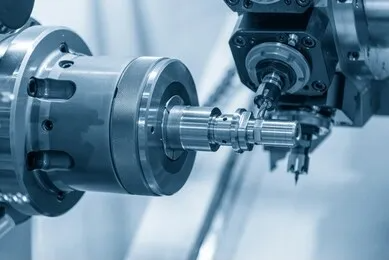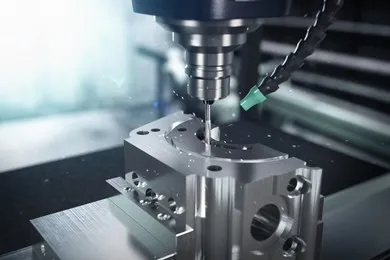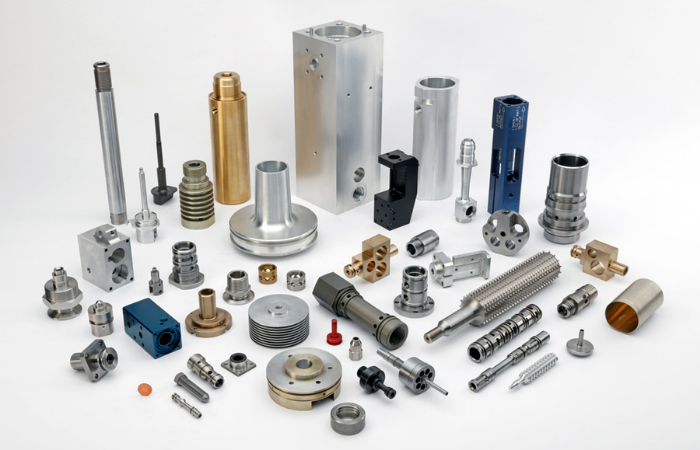CNC Milling and CNC Turning are two of the most important processes used in Computer Numerical Control (CNC) machining. The main significant difference made between these two processes is the type of cutting tool used: a both milling and turning machine uses a rotating cylindrical cutting tool while a plain milling and turning machine uses a non-rotating cutting tool. Each cnc machining process has its own advantages and disadvantages, so it is important to choose the right process for a given task.

Despite the fact that the CNC turns are regarded as an old innovation it is actually derived from a form of creation - using lathes - that is the easiest. The machine's horizontal or vertical configuration is dependent on weight and tolerance and the used raw material or materials are usually square in shape. CNC turn centers are designed to rotate the workpiece and move its tools to cut out any excess material needed in different cutting angles methods order to produce the desired form.
CNC turning is a machining process used to manufacture rotationally symmetric parts from raw materials using computerized controls. It involves the use of Computer Numerical Control (CNC) Turning Centers, which are machines with computerized controllers that drive the cutting tools. CNC Turning Centers can be programmed to produce complex parts with precise accuracy and repeatability, allowing for high-quality parts to be produced with minimal waste. CNC turning is used for industrial production in a wide range of industries, including automotive and aerospace. It is a popular choice for manufacturing precision components due to its high levels of accuracy and repeatability. Additionally, the use of computerized controls allows for fast production rates and reduced costs.
CNC Turning Centers are available in a variety of sizes and configurations to meet the needs of different industries. Each CNC Turning Center is equipped with laser cutting and tools, such as drill bits, end mills, and reamers which are used to cut and shape various materials into precise specifications. The cutting tools are attached to a front rotating spindle, that spins and rotates the tool along multiple axes. This allows for intricate parts to be cut precisely and accurately. CNC Turning Centers can also be equipped with a variety of other milling tools, such as deburring tools, scanning units, or polishing heads. CNC Turning is an extremely popular machining process in the modern manufacturing world due to its accuracy, repeatability, and cost savings. The speed of CNC machining and turning operations makes it an ideal process for large production runs with short lead times.

CNC turning offers great advantages in a round profile design as well as the capability to turn rounded shapes. It's a little harder to achieve perfect roundness with a number of other services like CNC machining services, milling and CNC routing. CNC turning also is very accurately and is a very effective tool to bore holes to precise dimensions with specified tolerances. CNC milling is possible with CNC machining to benefit both processes. The CNC is normally turned at the beginning of each step thereby allowing the machine operator to grind more asymmetric details on the part.
CNC turning operations are cost-effective and accurate machining processes that allow for efficient production. In CNC turning, the workpiece is stationary while the cutting tool is moved in a controlled fashion to shape the workpiece. This allows for greater accuracy and repeatability as compared to traditional machining processes. Additionally, different cutting methods can be used with CNC turning to further increase the efficiency of the machining process. For example, threading, facing, grooving, and turning can all be performed with CNC turning operations. Furthermore, the use of CNC helps reduce waste as only the necessary amount of material is removed in order to achieve the desired shape and size. As a result, CNC turning operations offer many advantages over traditional machining processes. They are cost-effective, accurate, and allow for efficient production with minimal waste.
The process of CNC grinding uses a variety of axes compared to CNC turning that uses only one tool. The most common is the 3-axis, a device that allows for three direction movement for the cutter. Limiting the machining process in three directions can set some limitations for the complex geometry the piece can create. It offers many kinds of machining equipments which provide various cutting methods, namely, hollow milling, mills, and face milling.
CNC Milling is a machining process in which a workpiece is held stationary and cut by a rotating cutting tool. The CNC Milling process allows for precision cutting and can be used to create parts with complex shapes and fine detail. CNC Milling is a subtractive manufacturing process, meaning that material is removed from the workpiece in order to create the desired shape. The cutting tool used for CNC Milling is typically a rotating end mill or drill bit, but can also include router bits and other specialized tools. The workpiece is typically held in place by a vise, clamp, or specialized fixture, and the cutting tool is moved along rotating workpiece on various axes to create the desired shape.
CNC Milling can be used to create parts with intricate contours and tight tolerances, and often requires fewer setup times than other machining processes. CNC Milling also allows for quick and efficient changes to the design of a part, making it an ideal choice for prototyping and production. The combination of automation, precision, and flexibility makes the CNC machine and Milling a powerful tool for many types of manufacturing applications.

Using CNC machined parts can be advantageous for both manufacturing businesses and consumers. Unlike lathes, mills can create various forms and sizes by using different types of equipment. Several cutting tooling can also be utilized in various operations like the grinding and the machining. Mills are used for machining and for post-machining, as they produce machined products single point cutting tool and equipment. For example, these tools will help you add detail to the turning, molding or 3D printing parts. CNC milling is also quick, repeatable and inexpensive at low prices. Therefore, the product combines manufacturing services and Rapid prototyping services.
CNC milling is one of the most important manufacturing processes, allowing manufacturers to produce components with great accuracy and repeatability. It allows for highly precise control of the cutting tools, which allows for faster production and increased efficiency. The use of CNC milling processes also ensures that parts are made with consistent quality and dimensions. Additionally, CNC milling offers flexibility in terms of part shape and size, since the program for the machine can be easily adjusted to accommodate different specifications. This allows for faster turnaround times and the ability to produce parts in a variety of materials, including metals, plastics, composites, and ceramics. CNC milling eliminates the need for skilled labor and reduces the cost of production as well, making it an economical and efficient process for any type of manufacturing. CNC milling also reduces the risk of errors, as well as the time required to produce components.

CNC milling machines are primarily built using digital prebuilt plans computer software and also use fabricated materials. CNC turning on CNC milling is identical to CNC lathe turning on CNC lathe, but it has differences in design and each machine can be used in different parts. What distinguishes the difference between CNC Lathes and CNC Mills is how the machine rotates and the parts are moved. CNC lathes rotate the workpiece and steel plate against the cutting tools for shaping the piece of material. Unlike CNC mill, machines, the tool rotation can be performed on bar stock. The difference between machines is subtle, but allows for rapid and effective creation of specific objects.
CNC milling and cnc turning advanced milling processes involve the material being held in place while the cutting tools rotate around it. CNC turning, on the other hand, requires the tools to maintain in the same place while the material is rotated at speed to create the exact shape. Although this is quite simplistic, there is much more to the processes than meets the eye.
CNC milling always produces discontinuous chips, while a CNC mill and turning can produce discontinuous, continuous and fragmented chips. CNC Turning and Milling are often used together in order to create complex parts more efficiently. This process require milling is especially useful for creating parts with very high precision and close tolerances, as well as for creating complex 3D shapes. CNC turning machines and milling machines can also produce parts that have both curved surfaces and intricate details, making them ideal for a wide range of applications.

CNC machine bed these machines typically use steel bars as material to form a piece. Generally, it may be some sort of aluminum or steel, but can also have a large variety of other metals including steel, nickel or other alloying metal. Various CNC machine-making machines can work with other materials such as wood. The ease of use of CNC machining machines suitable materials is dependent upon dozens of factors. Hardness, flexibility, melting point conductivity or any other properties of material can affect machining processes. Some CNC machines aren't built for machining flat, hard metals like aluminum.
CNC mills and lathes and a CNC lathe and mills are versatile tools used in many different industries. These machines use various machining methods to shape materials into a desired finished product. CNC lathes and mills are commonly used to create precision parts from a variety of materials, such as wood, plastic, metal, and composites.
CNC lathes have the ability to machine out cylindrical parts and components by rotating a part against cutting tools to shape and smooth its outer surface. This process is known as turning. Lathes are commonly used to work with materials such as aluminum, brass, copper, steel, and bronze.
CNC mills are sed to perform milling operations, which involve using a cutting tool to shape or remove material from a pre-existing material. CNC mills can be used to produce parts from materials such as wood, plastic, and metal. They are often used to machine parts with complex geometries irregular surfaces, such as 3D contours and slots.
CNC lathes and mills are powerful tools for machining materials into a desired shape. With the right tools computer programs and techniques, these machines can create precision parts from a vast array of materials, making them indispensable for many industries.
Overall, CNC Milling and Turning are two essential machining processes used by professionals in the manufacturing industry. CNC Milling is more suitable for creating complex parts with higher accuracy, while CNC Turning is better suited for producing cylindrical components. By combining the two processes, CNC machining services are able to offer a complete machining solution for various industries.